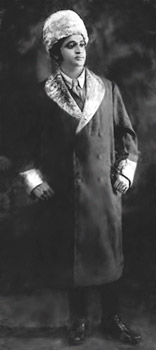दीनानाथ मंगेशकर

Pt. Deenanath Mangeshkar (29 December 1900 – 24 April 1942) was a well-known Marathi theatre actor, a Natya Sangeet musician and a Hindustani classical vocalist. He is also the father of well-known singers Lata Mangeshkar, Asha Bhosle, Meena Khadikar and Usha Mangeshkar as well as composer Hridaynath Mangeshkar.
Background
Pt. Deenanath Mangeshkar, popularly known as Dina, was born at Mangeshi, Portuguese India (present-day Goa on 29 December 1900.[His father, Ganesh Bhatt Navathe Hardikar (Abhisheki),[was a married Karhade Brahmin who served as priest at the famous Mangueshi Temple in Goa. His mother Yesubai was his father's mistress belonging to the Devadasi community of Goa,[1] which is now known as Gomantak Maratha Samaj. Since Deenanath was illegitimate (he did not inherit his father's Brahmin caste [ and born in Mangeshi village, he later, in his teens, adopted the surname "Mangeshkar," which means "of Mangesh." Mangesh is also the name of the deity worshipped in the Mangueshi Temple.
As a Devadasi, Yesubai often sang and danced at temple events and festivals. She is said to have had an unerring genius for music. Deenanath's father's surname was Hardikar, whose family performed the Abhishekam (ritual bathing) of the lingam of Shiva at Mangueshi Temple, thus they were known as Abhishekis.[5] The father of the Indian vocalist Jitendra Abhisheki was Deenanath's half-brother.
Career
Deenanath Mangeshkar started taking singing and music lessons from Shri Baba Mashelkar at the age of five. He was also to become a disciple at Gwalior school. He was fascinated by the variety and aggressive style of Gayanacharya Pundit Ramkrishna bua Vaze and became gandabandh shagird. In his youth, he travelled to Bikaner and took formal training in classical music from Pundit Sukhdev Prasad, father of Pundit Mani Prasad, of the Kirana Gharana. He joined the Kirloskar Sangeet Mandali and the Kirloskar Natak Mandali at the age of 11. Later, he left Kirloskar Mandali, and formed Balwant Mandali with his friends Chintamanrao Kolhatkar and Krishnarao Kolhapure. This new group had Gadkari's blessing, but shortly after the group was formed; Gadkari died in January 1919.
Deenanath's good looks and melodious voice won him popularity in the Marathi theatre. So much so that the then giant of the Marathi stage, Bal Gandharva publicly declared that he would welcome the entry of Deenanath in his organisation "by throwing a carpet of rupee coins under his feet".
During the period of 1935, he produced 3 films, one of them being Krishnarjun Yuddha. It was made in both Hindi and Marathi, and a song from it, sung by and filmed on Deenanath. Deenanath also studied Indian classical music under Ramkrishna Vaze. He also studied astrology.
Partly out of his interest in astrology and numerology, he believed that dramas with 5 letters, with anuswar (diacritical) on the third letter, were lucky for him. Examples : Ranadundubhi (रणदुंदुभी), Rajsanyas (राजसंन्यास), Deshkantak (देशकंटक).
The dramas produced by Deenanath were extremely popular amongst the masses due to his masterly presentation of the songs composed by Vaze Bua and the patriotic content.
Personal life
First marriage
Deenanath's first wife was Narmada (later renamed "Shrimati" by her in-laws). She was the daughter of Seth Haridas Ramdas Lad – a prosperous businessman of the town of Thalner (between Dhule and Jalgaon (Khandesh), Maharashtra. Deenanath and Narmada were married in 1922. Deenanath changed his wife's name to "Shrimati". She was 19 at the time and Deenanath was 21.
They had a daughter named Latika, who died in her infancy. Deenanath's wife died shortly thereafter.
Second marriage
Deenanath's second wife was his first wife's sister. Her name was Shevanti. Some sources claim that Deenanath named his second wife "Shrimati" as well.
The marriage of Deenanath and Shevanti was solemnised at a quiet ceremony within the house in 1927. Shevanti's mother chose not to attend.
Deenanath and his second wife had five children: Lata, Meena, Asha, Usha, and Hridaynath.
Their first child was named Hema. But Deenanath called her Lata in memory of his deceased daughter. The name stuck and it is by that name that his legendary eldest daughter, Lata Mangeshkar, is known today.
See above
Death
Mangeshkar on a 1993 stamp of India
Deenanath took to alcohol during the days of financial hardship in 1930s. After being ill for a few weeks, he died in Pune in April 1942. He was only 41 at the time of his death.
His family has erected a Deenanath Mangeshkar Hospital and research centre in his name in Pune.
Theatrical productions
Some of his theatrical productions, in which he sang and starred too, are
Manapaman (मानापमान) (written by K.P. Khadilkar)
Ranadundubhi (रणदुंदुभी) (written by Veer Vamanrao Joshi) Music composed by Vaze buwa
Punyaprabhaav (पुण्यप्रभाव)
Sanyasta Khadga (संन्यस्तखड्ग) (written by Veer Savarkar) Music composed by Vaze buwa
Rajsanyaas (राजसंन्यास) (written by Ram Ganesh Gadkari)
Deshkantak (देशकंटक)
Ram Rajya Viyog (रामराज्य वियोग)
लेख के प्रकार
- Log in to post comments
- 164 views
